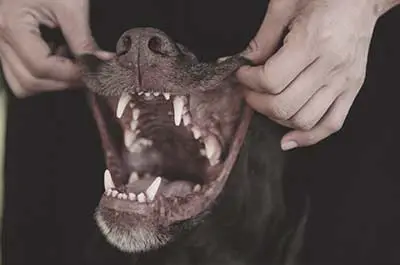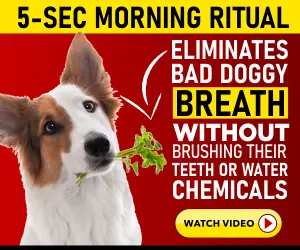Dental hygiene is important for humans, and it’s just as important for pets. Pets can get dental disease just like people do, and if left untreated, it can lead to other health problems. In this blog post, we will discuss ten ways that you can improve your pet’s dental hygiene. Follow these tips, and your pet will be on the road to healthy teeth and gums!
Tartar: first symptom of poor oral hygiene.
Pets are great companions, and most pet owners want to do everything they can to keep their furry friends healthy and happy.

Part of caring for a pet is ensuring its teeth are clean and healthy. Unfortunately, many pet owners are unaware that tartar can be the first symptom of poor oral hygiene.
Tartar is a yellow or brown deposit that forms on the teeth and is one of the first symptoms of poor oral hygiene.
When tartar builds up, it provides a perfect environment for bacteria to thrive. As the bacteria multiply, they produce an acidic substance that can break down tooth enamel.
In addition, tartar can make it difficult to remove plaque with a toothbrush. If left untreated, tartar can lead to gum disease, tooth loss, and other serious dental problems. For pet owners, it is important to be aware of the signs of tartar and to take steps to prevent it from forming.
Feed your pet a healthy diet.
One of the best ways to improve your pet’s dental health is to feed them a healthy diet. Believe it or not, what you feed your pet can also impact their dental hygiene. After all, our furry friends rely on us to take care of them, and that includes making sure they have healthy teeth and gums.
Decay and tartar buildup can lead to pain and tooth loss, so it’s important to be mindful of what you’re feeding your pet. By making a few simple changes to your pet’s diet, you can help improve their dental health and change how they relate to food. Just like with people, sugary and processed foods contribute to plaque buildup on teeth.
So, by switching to a diet that’s lower in sugar and higher in fiber, we can help change the way our pets’ mouths look – and smell. Plus, fiber-rich foods can help scrape away plaque as our pets chew. So, next time you’re at the pet store, pick up some food that will do double duty when it comes to keeping your pet’s teeth clean and healthy.
What to do if your pet has bad breath?
No one likes a pet with bad breath, but unfortunately, it’s a common problem. You can do a few things to help improve your pet’s breath. First, make sure they’re drinking plenty of water. A dehydrated pet is more likely to have bad breath. If your pet’s breath starts to stink, take them to the vet for a checkup. They may have an underlying dental issue that needs to be addressed.
In the meantime, give your pet some breath mints or parsley to help mask the smell. With a little effort, you can help your pet enjoy fresh breath all day long.
Feed them dry food instead of wet food to help reduce plaque buildup.
One simple change you can make to help reduce plaque buildup is to feed your cat dry food instead of wet food. Dry food is not only better for your pet’s teeth, but it’s also more affordable and easier to store. Wet food can cause plaque buildup on your pet’s teeth, leading to tooth decay and gum disease. On the other hand, dry food helps reduce plaque buildup by scraping it away as your pet chews.
Additionally, dry food is generally lower in calories and fat than wet food, making it a healthier option for pets prone to weight gain. So, switching to dry food is a good place to start if you’re looking to change your cat’s eating habits.
Tips on how to brush your pet’s teeth properly.
When most people think about taking care of their pet’s teeth, they only think about its impact on their pet’s breath. However, brushing your pet’s teeth regularly can also improve their overall health.

Poor dental hygiene can lead to gum disease, which can cause inflammation and pain. It can also lead to tooth loss and other serious health problems.
By taking the time to brush your pet’s teeth, you can help prevent these problems and change your relationship with your pet. When you brush your pet’s teeth, you are not only improving their health but also showing them that you care about them and want to keep them healthy.
While it may seem daunting at first, brushing your pet’s teeth is quite easy. You’ll need to purchase a pet-specific toothbrush and toothpaste, or you can even use a soft cloth or gauze pad and then get your pet used to the idea of having their teeth brushed.
Be sure to brush gently, as you don’t want to damage your pet’s gums. Once you’ve overcome this hurdle, you’ll be able to keep your teeth clean with just a few minutes of effort each day. And, as a bonus, your pet will likely appreciate the extra attention. So why not give it a try? You might be surprised at the difference it makes.
Schedule regular dental checkups.
Another important way to improve your pet’s dental hygiene is to schedule regular dental checkups with your veterinarian. Just like with people, it’s important to have a professional clean your pet’s teeth regularly. Depending on the health of your pet’s teeth, your vet may recommend having their teeth cleaned every six months to one year.
During a dental cleaning, your vet will remove any tartar or plaque that has built up on your pet’s teeth. They will also check for any signs of tooth decay or gum disease. If caught early, these problems can be treated before they cause serious health problems. So, be sure to schedule regular dental checkups for your pet and keep up with their oral health.
Invest in a water flosser to clean between their teeth and gums.
While brushing your pet’s teeth is a great way to improve their dental hygiene, it’s not the only way. You can also help to keep their teeth and gums healthy by using a water flosser. Water flossers are designed to clean between your pet’s teeth and gums, removing plaque and tartar that can cause gum disease.
To use a water flosser, fill the reservoir with water and then hold the tip against your pet’s teeth and gums. The water will flow through the tip and clean between their teeth and gums. Start slowly and increase the pressure gradually, as you don’t want to damage your pet’s gums. With regular use, a water flosser can help to keep your pet’s teeth and gums healthy.
Clean your pet’s teeth using hydrogen peroxide or baking soda if they develop plaque or tartar buildup.
Over time, plaque and tartar can build up on your pet’s teeth, causing tooth decay and gum disease. One way to clean your pet’s teeth is by using hydrogen peroxide or baking soda. Hydrogen peroxide is a natural disinfectant that can help remove plaque and tartar buildup. Baking soda is also effective at removing plaque and tartar, and it is also gentle on gums.
To use hydrogen peroxide, dampen a cotton ball with the solution and wipe your pet’s teeth. For baking soda, mix equal parts baking soda and water to form a paste. Use a toothbrush or your finger to apply the paste to your pet’s teeth and gums. Rinse with water when finished. Regular brushing with hydrogen peroxide or baking soda can help to keep your pet’s teeth clean and prevent plaque and tartar buildup.
Use dental toys and treats.
In addition to brushing your pet’s teeth and scheduling regular dental checkups, you can also help improve their dental hygiene by using dental toys and treats. Dental toys help remove plaque and tartar from your pet’s teeth as they chew. And, since they’re made specifically for pets, they’re safe to use and won’t damage your pet’s teeth.
Dental treats are another great way to help improve your pet’s dental health. These treats are usually high in fiber, which helps to scrape away plaque as your pet chews.
Plus, they often contain ingredients that help to reduce plaque and tartar buildup. So, if you’re looking for a way to improve your pet’s dental health, be sure to pick up some dental toys and treats the next time you’re at the pet store.
What to do if your pet has a dental emergency?
Many pet owners are unaware of what to do in the event of a pet dental emergency. If your pet is in pain or bleeding from the mouth, it is important to seek veterinary care immediately. The first step is to stay calm. It can be helpful to have the number of your veterinarian or a local pet hospital programmed into your phone, so you can easily call for help.
In the meantime, there are some steps you can take to help your pet feel more comfortable. For example, if your pet is bleeding, you can try applying pressure with a clean cloth.
If your pet is in pain, you can give them some over-the-counter pain medication designed for pets. You can also try to remove any foreign objects from their mouth, but be careful not to injure yourself or your pet.
It is also important to avoid giving your pet any human food or treats, as this can exacerbate their condition. By following these simple steps, you can help your pet stay calm and comfortable until it can receive professional treatment.
Conclusion.
Pets are family, and just like with our human family members, we want to do everything we can to keep them healthy and happy. Good dental hygiene is an important part of keeping your pet healthy, and there are many things you can do to promote good oral health for your pet.
Be sure to brush their teeth regularly, invest in a water flosser, and clean their teeth with hydrogen peroxide or baking soda if they develop plaque or tartar buildup. In a dental emergency, stay calm and call your veterinarian for help.
Following these simple tips can help keep your pet’s teeth and gums healthy and prevent painful dental problems.
Thanks for reading! I hope this was helpful.

Dive into the insights of Matthew Mansour, a seasoned life coach, fitness guru, and health mentor. With a portfolio boasting over 800 thought-provoking articles, Matthew is passionate about unraveling the intricate layers of the human psyche. His reading choices? Books that shed light on our unique human journey, helping him (and his readers) harness the power of the mind, transforming challenges into stepping stones.
Matthew proudly wears his badge as a self-help aficionado. His mantra? There’s always room to grow, learn, and be inspired. He thrives on gleaning wisdom from pioneers, turning their experiences into valuable lessons for all.
Always on the pulse of emerging trends, Matthew immerses himself in groundbreaking courses and research centered around life coaching and holistic health. Eager to impart his knowledge, he’s here to guide anyone keen on enhancing their life journey.
Beyond his professional persona, Matthew is a devoted animal lover, a proud New Jersey resident, and a doting husband and father. Dive into his self-improvement blog and let Matthew guide you towards a life filled with purpose and passion!
Reviewed By: Joanna Perez and Marcella Raskin
Edited By: Lenny Terra
Fact Checked By: Gabrielle J. Smith
Photos Taken or Curated By: Matthew Mansour

